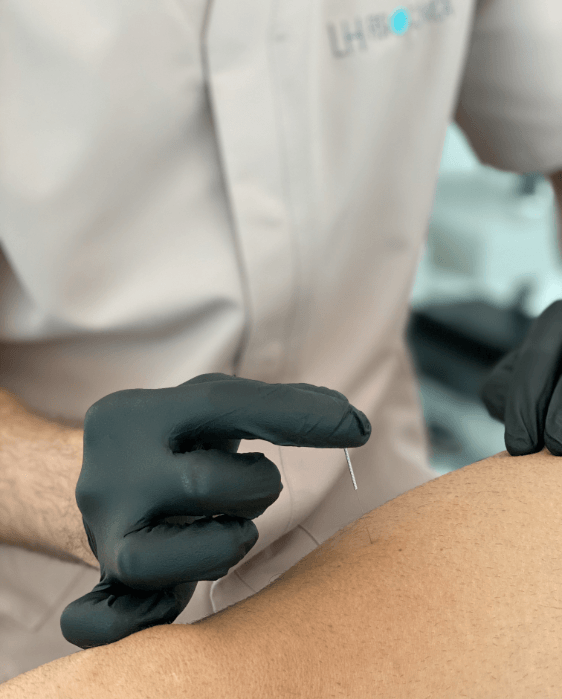Dry needling
Dry needling is an invasive technique aimed at deactivating muscle or myofascial trigger points in order to reset and relax the target muscle.
What is a trigger point?
A trigger point is a palpable nodule or hyper-irritable spot within a taut band of muscle (a group of fibers within the muscle holding greater tension than the rest), which, upon compression, generates pain and triggers a map of referred pain, that is, a characteristic and specific non-local pain for each trigger point. If it is an active trigger point, when pressed, the patient will associate it with his referred pain.
This technique consists of the introduction of a sterile needle into the muscle until it reaches the trigger point and stimulates the motor plate and neuromuscular spindle, immediately reducing the pain felt by the patient and producing a reflex muscular relaxation and increased elasticity. It is known as “dry” because no type of substance is injected while the technique is performed.
This technique can be performed in one of two ways: superficially (without reaching the trigger point), or deep (the needle passes through the trigger point).

Does it cause discomfort?
This technique can be uncomfortable when applied, and localized discomfort may be felt for 24-48 hours (similar to the stiffness felt after intense activity). However, it is a good treatment option to consider due to the manner in which it efficiently provides rapid pain relief, which means it works better in conjunction with other active and passive treatment techniques.
In some cases, its application requires the use of an ultrasound machine to guide us and perform it safely, especially when it is applied to hard-to-reach muscles or where there is some risk of puncturing an important and delicate anatomical structure, such as major blood vessels (arteries, veins) , nerves, viscera, or lymph nodes.
INDICATIONS
• Myofascial Pain Syndrome
• Muscle hypertonia/stiffness
• Distance referred pain
• Contractures
• Mobility limitation
Contraindications
- Fear of needles
- Coagulation problems
- Areas with wounds or scars, tattoos, blemishes, skin lesions
- Allergies to metals (such as nickel, although there are needles made of various materials, this must be evaluated and taken into account)
- In pregnant women (in areas close to the pelvic and abdominal regions
Frequently asked questions - Dry needling
In what cases is dry needling indicated?
Dry needling is primarily indicated for the treatment of myofascial trigger points that cause muscle pain. It is also used for conditions such as tendinopathies, lower back pain, neck pain, and other musculoskeletal issues where trigger points are identified as the source of pain.
Is dry needling painful?
During dry needling, patients may feel a slight prick and, in some cases, a local twitch response in the treated muscle. These sensations are usually brief and tolerable. After the treatment, it is common to experience soreness similar to muscle aches, which can last between 12 and 48 hours.
How many dry needling sessions are needed?
The number of sessions varies depending on the patient’s condition and response to treatment. Generally, between 3 and 6 sessions are required, spaced weekly. If no improvement is observed after the initial sessions, the physiotherapist may reconsider the treatment plan.
Does dry needling have side effects?
The side effects of dry needling are minimal. They may include post-needling soreness, which typically subsides within 48 hours, and occasionally, a small bruise if a blood vessel is punctured. It is essential that the technique is performed by a trained professional to minimise risks.
What is the difference between dry needling and acupuncture?
Although both techniques use needles, dry needling and acupuncture differ in their approach and objectives. Dry needling focuses on deactivating specific myofascial trigger points to relieve muscle pain, while acupuncture, based on traditional Chinese medicine, aims to balance the body’s energy by inserting needles at specific points along energy meridians.
What should I do after a dry needling session?
After a dry needling session, it is recommended to avoid intense physical activity for the first 24 hours. Gentle stretching and staying well-hydrated are beneficial. If post-needling soreness occurs, applying local cold therapy can help alleviate discomfort.
Are there contraindications for dry needling?
Yes, dry needling is contraindicated in cases of skin infections in the treated area, blood clotting disorders, pregnancy (especially during the first trimester), and in patients with extreme fear of needles. It is crucial for the physiotherapist to assess each individual case before applying the technique.
